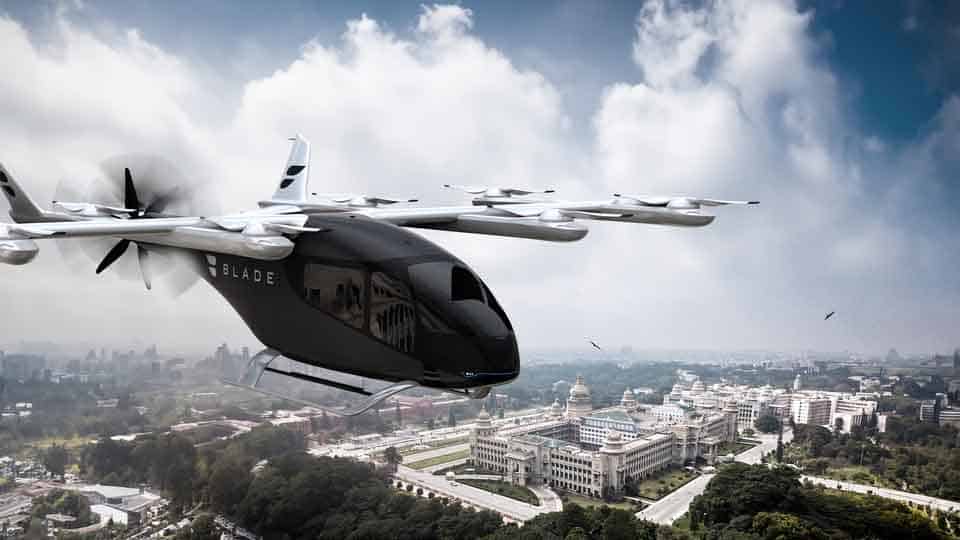Aerospace
A New Era for Bangalore: Eve Air Mobility and Hunch Mobility Redefine Commuting with eVTOL

In a pioneering collaboration, Eve Air Mobility (“Eve”) (NYSE: EVEX; EVEXW) and Hunch Mobility (“Hunch Mobility”), a joint venture between Hunch Ventures and Blade Air Mobility, Inc. (NASDAQ: BLDE), have unveiled plans to initiate the first electric commuter flights to Bangalore, India. This strategic announcement designates Bangalore as the inaugural city in the region to host urban air mobility flights facilitated by electric vertical takeoff and landing (eVTOL) aircraft, marking a significant milestone in sustainable and innovative transportation solutions.
Key Points:
- Partnership Announcement:
- Eve Air Mobility (Eve) and Hunch Mobility are collaborating to introduce electric commuter flights in Bangalore, India.
- Bangalore will be the launch city in the region for electric vertical takeoff and landing (eVTOL) aircraft.
- Collaborative Efforts:
- Both companies will work with local, state, and federal officials, as well as infrastructure, energy, and technology providers.
- The goal is to establish the necessary infrastructure for the introduction of eVTOL flights in Bangalore.
- Urban Air Mobility in India:
- The collaboration aims to co-create an urban air mobility ecosystem in India, addressing transportation challenges in densely populated cities.
- Market Significance:
- India is identified as a crucial market for urban air mobility, offering an efficient and affordable mode of transportation to ease commuting in highly populated cities.
- Commitment to Sustainability:
- The partnership emphasizes the commitment to contribute to India’s growth by reducing road congestion through eVTOL flights.
- eVTOL flights are expected to democratize short-haul air mobility with affordable fares and zero carbon emissions.
- Bangalore’s Significance:
- Bangalore, with a population of over 13 million, is chosen as the launch city due to its high population density.
- The introduction of eVTOL flights is expected to reduce carbon footprint, noise, and flying costs.
- Eve’s eVTOL Features:
- Eve’s eVTOL is 100% electric with a range of 100 kilometers (60 miles).
- It employs a lift + cruise configuration with dedicated rotors for vertical flight and fixed wings for cruise.
- Pilot Project and Data Collection:
- Eve was the first eVTOL manufacturer to announce a Letter of Intent (LOI) in India with Hunch Mobility committing to purchase 200 eVTOLs.
- A three-month-long pilot project was conducted in Bangalore to collect data on operations and customer experiences.
- Economic Impact:
- Introduction of eVTOL flights is expected to create new employment opportunities, including pilots, technicians, training, and technical services.
- The development of necessary infrastructure is anticipated to contribute economic value to the community.
- Timeline for Service:
- Eve’s eVTOL is scheduled to enter into service in 2026, offering a quick and economical transportation option in Bangalore’s urban environment.

Aerospace
Boeing Transfers Rocket Stage to NASA, Paving Way for Human Moon Mission

Boeing has achieved a significant milestone by providing NASA with the second core stage of the Space Launch System (SLS) rocket.
This crucial component, crafted at NASA’s Michoud Assembly Facility (MAF), is set to propel the Artemis II crew into lunar orbit, marking humanity’s return to deep space after a 50-year hiatus.
The monumental Boeing-built rocket stage, the largest element of the Artemis II mission, will embark on a journey aboard the Pegasus barge, traveling 900 miles to NASA’s Kennedy Space Center.
Comparison of two legendary aircraft B777x vs B747 aircraft:Click here
Upon arrival, it will be meticulously integrated with other essential Artemis II components, including the upper stage, solid rocket boosters, and NASA’s Orion spacecraft within the iconic Vehicle Assembly Building. This intricate integration process is a vital step toward the eagerly anticipated Artemis II launch, slated for 2025.
“Boeing-built products helped land humankind on the moon in 1969, and we’re proud to continue that legacy through the Artemis generation,” remarked Dave Dutcher, vice president and program manager for Boeing’s SLS program. “Together, with NASA and our industry partners and suppliers, we are building the world’s most capable rocket and paving the way to deep space through America’s rocket factory in New Orleans.”
NASA, Lockheed Martin Reveal X-59 Quiet Supersonic Aircraft:Click here
The delivery of Core Stage 2 marks a significant achievement in the evolution of the SLS rocket. Towering over 200 feet and powered by four RS-25 engines, this core stage, coupled with two solid-fueled booster rockets, will generate a staggering 8.8 million pounds of thrust. This immense power is crucial to launching Artemis II and future missions into the vast expanse of space.
The SLS rocket stands unparalleled in its capability to transport both crew and substantial cargo to the moon and beyond in a single launch. Its extraordinary capacity will facilitate the delivery of human-rated spacecraft, habitats, and scientific missions to destinations including the moon and Mars, ushering in a new era of space exploration.
-

 Travel1 week ago
Travel1 week agoAir India to Expand US Operations with Three New Routes After a Decade
-

 Travel2 weeks ago
Travel2 weeks agoWhy We Should Avoid These Stamps in a Passport
-

 Airlines1 month ago
Airlines1 month agoInvestigations Reveal Fake Chinese Titanium in Boeing and Airbus Jets
-

 Tech4 weeks ago
Tech4 weeks agoChina’s CATL Plans 1,800-Mile Electric Plane Launch by 2027
-

 Airport3 days ago
Airport3 days agoTop 10 Largest Airports in the World by Size
-

 Aerospace4 weeks ago
Aerospace4 weeks agoChina’s Fighter Jets Turn Wings into Autonomous Drones
-

 Airlines4 days ago
Airlines4 days agoAir India Rolls Out A350s for Delhi-New York JFK and Newark Routes
-

 Defence3 weeks ago
Defence3 weeks agoBoeing Enhances Chinook with New Engines and Block II Upgrades at $96 Million







